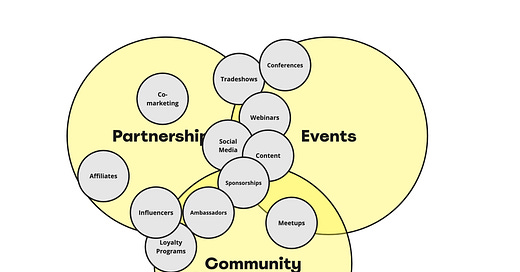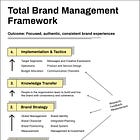422. Partnerships, Events, Community 🎶
Inside the Venn diagram of partnerships, events, and community for your marketing strategy
Hi there 👋
There’s a group of engineers competing to create the worst UI imaginable — and they’re off to a pretty good start! Here’s a Twitter thread that captures some of the best (worst?):
Imagine being a product marketer for any of those experiences!
Wishing you a great week ahead,
Kevan
(ᵔᴥᵔ)
Thank you for being part of this newsletter. Each week, I share playbooks, case studies, stories, and links from inside the startup marketing world and my time at Oyster, Buffer, and more.
Say hi anytime at hello@kevanlee.com. I’d love to hear from you.
The three-pronged approach to partnerships, events, and community
The Rule of Three states that any ideas, thoughts, characters or words that are bundled into groups of three are more effective and memorable.
Three little pigs.
The good, the bad, and the ugly.
Harry, Ron, and Hermione.
Location, location, location.
It’s nice when this works out within marketing strategy, too. I’ve written before about my three pillars of marketing and the three Ps of branding.
Recently another group of three has popped onto my marketing radar: partnerships, events, and community.
How partnerships, events, and community fit together
Partner marketing is a collaboration between two brands.
Event marketing is the practice of bringing people together in real-time.
Community-building is all about connecting people to people.
As you can see, they all share a common ground of building relationships, strategically and at scale. For this reason, I like to put these roles together as part of a larger brand marketing team where the leaders of partnerships, events, and community can collaborate and be more than the sum of their parts. How does the saying go .. 1+1=3? In this case, I guess it’s 1+1+1=5?
On small teams, you might be tempted to have all three disciplines live with one person. If so, I’d advise to be clear about what you will do and what you won’t do because there is an iceberg of work hidden under the surface of these areas.
My preference when starting out is to divide the three disciplines into two roles:
Partner marketing manager
Community and events manager
(You can see how I’ve written JDs for these roles here and here.)
Typically, what you’ll find is that the most collaborative discipline among the three is events. Partner marketers may be the ones sourcing guests and identifying co-marketing opportunities, and a community and events manager may be the one designing the event experience and how people will connect with you and your brand.
Here’s a more detailed way to look at the overlap.
Types of partner marketing include:
Strategic B2B partners
Social influencers
Affiliates
Loyalty programs
Ambassadors
Sponsorships
Premium content
Types of community-building include:
Digital community spaces (Slack, Circle)
Sponsorships
Meetups
Social media
Forums
Types of event marketing include:
Meetups
Tradeshows
Webinars
Conferences
Social media
Content
Check out this Miro board to see a visual of how some of these strategies and tactics overlap within the broader Venn diagram of partnerships, events, and community.
Three tips to further align your partnerships, events, and community teams
Fitting to end this newsletter with another list of three! Here are some ways that I’ve found to better coordinate the intersection of these three disciplines when working with a team of two or a team of twenty.
1. Decide on a shared goal
Partly, this will be easier if these disciplines sit within the same sub-department, like brand marketing. They will share brand marketing’s number one goal, which may be brand awareness or website traffic.
(As an alternative, some companies will have partner marketing and event marketing live within growth marketing so that they can contribute directly to a revenue or lead goal. I’m of the mind that you should track the revenue contribution of both partner and event marketing but that you shouldn’t ignore the massive leverage these areas have for building a brand.)
You can even bring this goal focus into the projects themselves. For instance:
Align everyone on the goal for your appearance at SaaStr. If the goal is positive ROI, then you might host a dinner party for prospects, organized by partner marketing. If the goal is brand awareness, then community might throw a mixer for fans.
2. Divide and conquer, based on audience
One of the ways that these three disciplines diverge (slightly) is with audience.
Partner tends to focus more on brands and the strategic relationships with people who work for those brands. Community focuses more on your audience at large, people who are already connected to your brand somehow either as a follower, a prospect, or a customer. Events focus on internal collaborators and external vendors.
When working together, it can be helpful to call out the specifics of who you envision for the different parts of your strategy. For instance:
If your ambassador strategy is for brand awareness, it may fall to community to coordinate with members of your audience
If your webinar approach is about education, your partner marketer may choose to bring in subject-matter experts from like-minded brands
If your event strategy hinges on a long-tail of niche events, your events person may lead that effort to coordinate how sales reps show up and network on the floor
3. Watch out for too much overlap — or not enough (especially around promotion)
Content and promotion tend to be the most troublesome areas of this three-discipline collaboration — either because you’re duplicating effort because everyone’s promoting everything or you’re not promoting at all because everyone thinks it’s someone else’s job.
The great thing about these three disciplines is that they all can contribute as content creators and channel managers. They’ve all probably had experience doing:
Social media
Content marketing
PR and comms
Email
Product marketing
You name it, these folks have probably been asked to do it at some point.
So when it comes to the work of promoting an upcoming program, it’s important to be clear about who does what. I’ve found that the best way to do this is to be flexible from program to program and to adapt based on what else you have going on within your marketing strategy. This is where project management comes in handy: Assign work based on the project, not on the job title — because we all know how much bandwidth can change when you’re in the day-to-day!
Over to you
What has been your experience with partnerships, events, and community?
It’d be great to hear your thoughts! Feel free to reply to this email or send me a note at hello@kevanlee.com.
About this newsletter …
Hi, I’m Kevan, a marketing exec based in Boise, Idaho, who specializes in startup marketing and brand-building. I previously built brands at Oyster, Buffer, and Vox. Each week, I share playbooks, case studies, stories, and links from inside the startup marketing world. Not yet subscribed? No worries. You can check out the archive, or sign up below:
Thank you for being here! 🙇♂️
I’m lucky to count folks from great brands like these (and many more) as part of this newsletter community.









